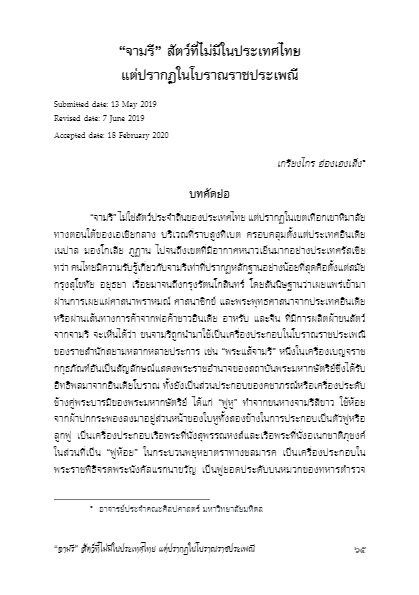“จามรี” สัตว์ที่ไม่มีในประเทศไทย
แต่ปรากฏในโบราณราชประเพณี
เกรียงไกร ฮ่องเฮงเส็ง
บทคัดย่อ
“จามรี” ไม่ใช่สัตว์ประจำถิ่นของประเทศไทย แต่ปรากฏในเขตเทือกเขาหิมาลัยทางตอนใต้ของเอเชียกลาง บริเวณที่ราบสูงทิเบต ครอบคลุมตั้งแต่ประเทศอินเดีย เนปาล มองโกเลีย ภูฏาน ไปจนถึงเขตที่มีอากาศหนาวเย็นมากอย่างประเทศรัสเซีย ทว่าคนไทยมีความรับรู้เกี่ยวกับจามรีเท่าที่ปรากฏหลักฐานอย่างน้อยที่สุดคือตั้งแต่สมัยกรุงสุโขทัย อยุธยา เรื่อยมาจนถึงกรุงรัตนโกสินทร์ โดยสันนิษฐานว่าเผยแพร่เข้ามาผ่านการเผยแผ่ศาสนาพราหมณ์ ศาสนาซิกข์ และพระพุทธศาสนาจากประเทศอินเดีย หรือผ่านเส้นทางการค้าจากพ่อค้าชาวอินเดีย อาหรับ และจีน ที่มีการผลิตผ้าขนสัตว์จากจามรี จะเห็นได้ว่า ขนจามรีถูกนำมาใช้เป็นเครื่องประกอบในโบราณราชประเพณีของราชสำนักสยามหลากหลายประการ เช่น “พระแส้จามรี” หนึ่งในเครื่องเบญจราช กกุธภัณฑ์อันเป็นสัญลักษณ์แสดงพระราชอำนาจของสถาบันพระมหากษัตริย์ซึ่งได้รับอิทธิพลมาจากอินเดียโบราณ ทั้งยังเป็นส่วนประกอบของคชาภรณ์หรือเครื่องประดับช้างคู่พระบารมีของพระมหากษัตริย์ ได้แก่ “พู่หู” ทำจากขนหางจามรีสีขาวใช้ห้อยจากผ้าปกกระพองลงมาอยู่ส่วนหน้าของใบหูทั้งสองข้างในการประกอบเป็นตัวพู่หรือลูกพู่ เป็นเครื่องประกอบเรือพระที่นั่งสุพรรณหงส์และเรือพระที่นั่งอเนกชาติภุชงค์ ในส่วนที่เป็น “พู่ห้อย” ในกระบวนพยุหยาตราทางชลมารคเป็นเครื่องประกอบในพระราชพิธีจรดพระนังคัลแรกนาขวัญเป็นพู่ยอดประดับบนหมวกของทหารตำรวจ และราชองครักษ์ในพิธีสวนสนาม เป็นส่วนประกอบของเครื่องแขวนตามประตูและหน้าต่าง และเป็นเครื่องประดับอาวุธจำพวกหอกและทวนตามตำรายุทธพิชัยสงคราม เป็นต้น จึงเป็นที่มาของความสนใจศึกษาประวัติความเป็นมาของการนำขนจามรีมาใช้ในโบราณราชประเพณีของไทย
คำสำคัญ: จามรี, โบราณราชประเพณี, เบญจราชกกุธภัณฑ์, คชาภรณ์
(ตีพิมพ์ใน วารสารไทยศึกษา ปีที่ 16 ฉบับที่ 2 (กรกฎาคม-ธันวาคม 2563) หน้า 64 – 95)
Yak: The Animal Not Native to Thailand but
Native in Its Ancient Royal Tradition
Kriangkrai Honghengseng
Abstract
The yak is not an animal indigenous to Thailand, living in the areas of the Himalaya Range in the southern part of Middle Asia and the Tibetan Plateau, including India, Nepal, Mongolia, Bhutan to Russia. However, Thai people have had some knowledge about this animal at from the Sukhothai and Ayutthaya, until the early Rattanakosin period. This knowledge is assumed to have derived from the dissemination of Brahmanism, Sikhism and Buddhism by Indians, or from trade done by Indian, Arabian or Chinese merchants who produced yak wool. Yak wool has been used in Thai royal traditions for many occasions and in diverse manners. For example, it is the main part of “Yak Tail Fan”, a part of the royal regalia as a symbol of the monarch, showing the influence of Indian culture. Royal elephants are decorated with tassels made from white yak tail that hang down in front of their ears. The royal barges Suphannahong and Anekkachatphutchong in the grand royal barge procession have yak tail tassels in their bows. In addition, yak tail serves as a main component of the royal ploughing ceremony as a decoration on the hat worn by royal guards while marching in the color ceremony. As well, yak hair is used as ornaments for windows and gates and adorns spears and lances according to the treatise on war strategy. However, despite its extensive use, little research has been done on yak wool by Thai scholars. This paper aims to investigate the appearance of this exotic material in Thai royal tradition.
Keywords: yak, Thai royal traditional, royal regalia, ornaments of the royal Thai elephants
(Published in Journal of Thai Studies Volume 16 Number 2 (July – December 2020) Page 64 – 95)
บทความ/ fulltext :3_Kriangkrai.pdf
